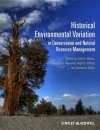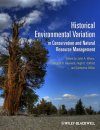![Historical Environmental Variation in Conservation and Natural Resource Management Historical Environmental Variation in Conservation and Natural Resource Management]()
Click to have a closer look
About this book
Customer reviews
Biography
Related titles
About this book
In North America, concepts of Historical Range of Variability are being employed in land-management planning for properties of private organizations and multiple government agencies. The National Park Service, U.S. Fish & Wildlife Service, Bureau of Land Management, U.S. Forest Service, and The Nature Conservancy all include elements of historical ecology in their planning processes. Similar approaches are part of land management and conservation in Europe and Australia. Each of these user groups must struggle with the added complication of rapid climate change, rapid land-use change, and technical issues in order to employ historical ecology effectively.
"Historical Environmental Variation in Conservation and Natural Resource Management" explores the utility of historical ecology in a management and conservation context and the development of concepts related to understanding future ranges of variability. It provides guidance and insights to all those entrusted with managing and conserving natural resources: land-use planners, ecologists, fire scientists, natural resource policy makers, conservation biologists, refuge and preserve managers, and field practitioners. The book will be particularly timely as science-based management is once again emphasized in United States federal land management and as an understanding of the potential effects of climate change becomes more widespread among resource managers.
Customer Reviews
Biography
John Wiens is a landscape ecologist and conservation scientist who was on the faculties of several universities in the United States before joining The Nature Conservancy as Chief Scientist in 2002. He has published over 200 scientific papers and six books, and has conducted research in Europe, South America, and Australia as well as the United States. He is currently Chief Conservation Science Officer at PRBO Conservation Science in California and is a visiting faculty member at the University of Western Australia in Perth. He lives in Corvallis, Oregon.
Hugh Safford is Regional Ecologist for the USDA Forest Service Pacific Southwest Region, which includes California, Hawaii, and the Pacific Territories, and a research faculty affiliate with the Department of Environmental Science and Policy, University of California-Davis.
Greg Hayward, Regional Wildlife Ecologist with the U.S. Forest Service in Alaska is a population ecologist with a passion for helping resource managers understand the trade-offs associated with difficult land management decisions. As a conservation practitioner Greg brings an academic perspective from faculty positions at the University of Idaho and University of Wyoming. Greg's research extends from boreal owls and flying squirrels to Amur tigers and cutthroat trout with a focus on the consequences of broad scale ecological disturbance on wildlife dynamics.
Casey Giffen, most recently a biological scientist with the U.S. Forest Service National Office in Washington, DC, specializes in regulatory compliance and land management planning. Prior to working with the National Office she spent time in the eastern and western regions of the country working in forest management and natural resource planning. She has over 15 years of experience working with national, regional, and forest-level land management programs.




































